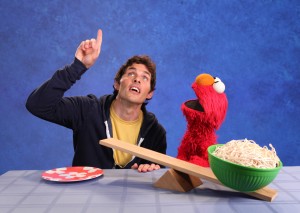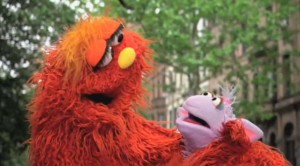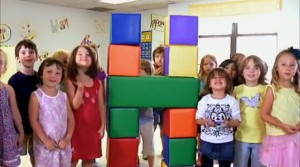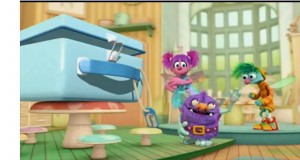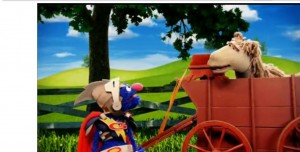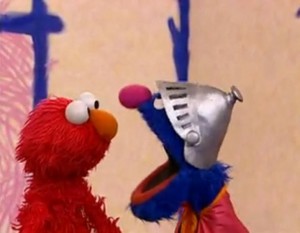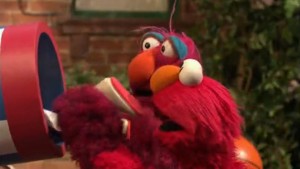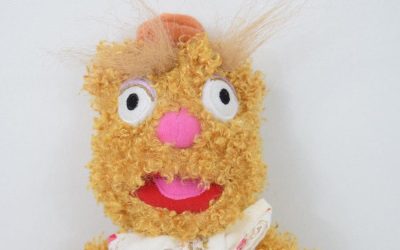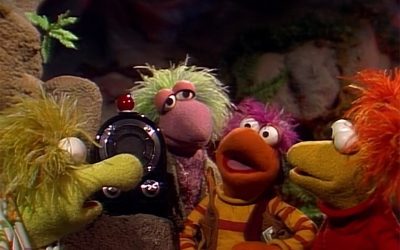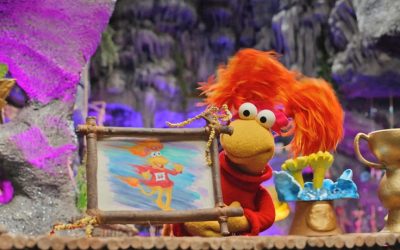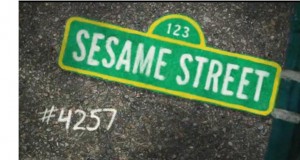 Sesame Street’s 42nd season debuts today (September 26) with an episode named after a Matthew McConaughey movie. Since 4257 episodes is an important milestone, we decided to do something special. Instead of trusting just one Sesame Street fan to review it, we enlisted two – occasional Muppet blogger Anthony Strand, and Early Childhood Special Education Teacher Rosalynn Strand. They will discuss each segment, with Anthony focusing on entertainment value and Rosalynn focusing on educational content.
Sesame Street’s 42nd season debuts today (September 26) with an episode named after a Matthew McConaughey movie. Since 4257 episodes is an important milestone, we decided to do something special. Instead of trusting just one Sesame Street fan to review it, we enlisted two – occasional Muppet blogger Anthony Strand, and Early Childhood Special Education Teacher Rosalynn Strand. They will discuss each segment, with Anthony focusing on entertainment value and Rosalynn focusing on educational content.
Anthony: Four and a half years ago, I wrote a piece for this website mocking the “Sesame Street is no good anymore. Why can’t it be more like it was in my childhood?” mentality so often expressed by people who haven’t seen the show in years. Now I fear I’m becoming that character for real. Because the season premiere, while not totally devoid of charm, didn’t exactly give me hope for the show’s future.
Rosalynn: I’m totally one of those people, and I’m okay with that! I show clips of Sesame Street in my classroom, and the majority of them have that little “Classic” symbol on them. I’ve taught all of my co-workers the Ladybug’s Picnic. There are so many different versions of the alphabet, and I’ve played all of them from Ladysmith Black Mambazo to Gabi backed up by her mom and Gina.
Anthony: Part of me thinks that it isn’t fair to compare the current series with the show’s golden age. Sesame Street in the 1970s is one of mankind’s all-time greatest achievements, and most of the people involved have moved on, either to other projects or to the after-life.
Rosalynn: And most of the puppets have changed hands, too.
Anthony: But on the other hand, the current crew is theoretically performing the same job – educate young children and entertain people of all ages. For me, at least, this episode didn’t meet the latter goal very well at all.
Rosalynn: And I’m just really confused about which children they’re trying to educate.
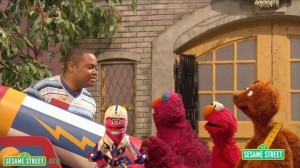 Street Scene – Failure to Launch
Street Scene – Failure to Launch
Anthony: In the street scene, our old friends Telly, Elmo and Baby Bear are playing basketball catch in the courtyard, when a little guy named Hubert the Human Cannonball shows up. He has just one goal in life – to be launched from a cannon precisely five feet into a bucket of blue gelatin.
The segment has some mildly amusing material, mostly from Telly. He worries that Hubert’s audience will be let down if he fails, and worried Telly is almost always funny Telly in my book. The story also wrings some laughs out of Hubert’s “fans”, which are just automatic cheering generated by a machine. And even when it isn’t that funny, it’s nice just to spend time with these characters.
But you were a lot less enthusiastic about the use of the word “engineer” to describe the process of designing and building a new method for launching Hubert. Why’s that?
Rosalynn: Engineer? Are you kidding me?! Preschoolers need to learn how to build blocks first. They need to know what a construction worker is before they know what an engineer is. Construction worker is concrete, engineer is abstract. Everything has to be STEM, STEM, STEM.
Anthony: Well, the segments have gotten longer. They have fewer segments, but they go more in-depth, at least in theory.
Rosalynn: But they can’t even decide who the audience is.
If they’re targeting it younger with repetition, why is the curriculum so high? They’re asking kids to have higher order thinking skills before they have the basics. Talking about units of measurement, launching, problem-solving – it doesn’t match up. The curriculum is missing the basic content it used to have. And it would hold little kids’ attention better if it used shorter segments like it used to.
3-and-4-year-olds are learning the alphabet now, and they need that repeated frequently and in small chunks. That’s why “the letter of the day and number of the day” were brilliant concepts. If they had two segments about counting to five, and then they had the man being shot five feet out of a cannon, it’d make sense. But instead they expect kids to glean that basic counting out of this really long street scene, which will be confusing for little kiddos.
It seems like they’re so intent on getting kids to problem solve and apply new information that they’re not teaching directly, which they used to do. And back then, they still had the street scenes where they could apply it. When it was broken up, it gave them a chance for direct instruction followed by application. Now that it’s this big old street scene, where’s the direct instruction?
Anthony: I guess the idea is that it will come in the following segments, but that doesn’t really happen, as we’ll see.
Anyway, the next segment is Elmo and James Marsden attempting to “engineer” an automatic spaghetti server using a wedge and board. But instead of getting the spaghetti on the plate, it just hurls it all over the place, including on their heads! Then they both look at the camera and say “Engineer!” That’s kind of funny, I guess. But what did they engineer? It didn’t perform the task they designed it to do. What does that teach kids?
Rosalynn: They have the material here for making mistakes, but they just skip over it. Engineering is a well thought-out process, and this isn’t it! This would make so much more sense with Grover doing it and James helping him when he makes mistakes. James could say “An engineer needs to look at his entire process before building it. He needs to measure how far the bowl can go.”
If they can’t teach the word right, they shouldn’t teach it. Or they could have mentioned that it’s a simple tool! Kids actually learn that in kindergarten. They could have mentioned the supplies they needed or how they got them. Engineers think about these things. It’s just very disappointing.
Anthony: Sure. Next, Murray visits the New York Hall of Science. I’ve always found the high-pitched voice Joey Mazzarino uses for Murray and other characters to be very grating, but I really like Murray’s enthusiasm. Here he and Ovejita (along with employees of the New York Hall of Science) help kids make rockets out of straws, clay, and construction paper fins.
Again, I recognize that adults aren’t the target audience for Sesame Street, but watching this, I find myself trying to justify it by saying “Well, it could be a lot worse.” That didn’t used to be necessary! Take, for example, the season 6 premiere, found on the Old School Volume 2 DVD set. It’s packed full of funny bits, terrific songs, and bizarre animations. I genuinely enjoy all 58 minutes of it, and that’s true of most episodes I’ve seen from the show’s first thirty seasons or so.
The show is still capable of hilarity for adults. Spider-Monster and the Glee parody are evidence of that –
Rosalynn: Yeah, the Glee thing is awesome. I’ve made up songs in class about the two sounds of the letter G. It’s hard whenever consonants make two sounds, and it confuses most kids. This one, they can giggle right along with their parents while learning it. Get it? Giggle?
Anthony: Gee, that’s great! But we don’t get much in this particular episode (with one exception that we’ll get to later). If this was a new show with Henson puppets, I’d probably tune in for the premiere, think “That’s kind of cute” and then never think about it again. It’s not that I need it to appeal to me. If it’s going after one crowd, I’m glad that crowd is kids rather than adults. But it still makes me a little sad.
That was a long tangent, but my point is – Murray and his rockets aren’t very entertaining, but are they educational at least?
Rosalynn: They could have been, but again, they miss all of the obvious opportunities. They didn’t count the fins, they just said the number. They teach kids how to engineer rockets but not how to launch them. They could have taught them how to make a soda-bottle rocket. They could have taught them how to make paper airplanes. There’s lots of things kids can do, but they chose something that kids can’t even replicate.
Anthony: But then you got a happy surprise – the “H is for Helping” segment, in which some kids build a letter H out of blocks and talk about various ways to help.
Rosalynn: Yeah! That’s awesome! You’ll notice the kids didn’t say engineer because kids don’t say that. They say that they built it. I could see my kids mimicking that. But why didn’t they talk about helping beforehand? Helping is social-emotional learning, making mistakes, following directions, and so far they’ve ignored all chances for it. But this feels like an old segment – it teaches something, it’s fun, and it’s obvious who the message is for.
Anthony: The other classic-style segment is “The Adventures of Salty and Pierre,” where a set of salt and pepper shakers look for the number 5 in their yard. I don’t have much to say about it, but it was fun.
Rosalynn: And the fact that everything is made of food and kitchen products is pretty cool.
Anthony: To me, this maybe feels the least like old Sesame Street of anything currently on the show. For that reason, I’ve struggled a lot with it ever since it premiered. A parent flipping the channels could stop on it and think this is some generic show, and that kind of troubles me. One of Sesame‘s great strengths is that parents and even grandparents grew up with it. But this isn’t that show at all. It’s not that I need the show to stay exactly the same, but for 29 seasons it had essentially the same format. “Abby’s” is almost unrecognizable as SS, and I’d like it a lot more if it was an independent series.
But on the bright side, despite being stuck in the middle of Sesame Street, it’s basically just a wacky sitcom, and a pretty a good one. The gang are all fun characters who serve different functions in the stories, and the designs are beautiful. I’m especially fond of twitchy, nervous Gonnigan, who I’d love to see in Muppet form someday.
This story, where the kids accidentally open Pandora’s lunchbox, was a pretty fun one. They have to match up the shapes in the lunchbox to the shapes of the living foods that have escaped, and I really dug the sequences where the various foods assault them.
Rosalynn: Yeah, it’s cute. I really like “Pandora’s lunchbox” and most of the story. The only thing I don’t like is the freaking hexagon!
Anthony: By which you mean that the three shapes are a rectangular juice box, a circular tortilla, and six triangle-shaped chips combining to form a hexagon?
Rosalynn: What’s wrong with a triangle? Chip = Triangle would have been enough of a lesson. If you can’t instantly figure out that a box is a rectangle, you sure aren’t going to figure out that you can use six triangles to make a hexagon. Is it possible that they think “The two-year-old is going to really get a kick out of the rectangle, but after he’s done, his nine-year-old brother is going to want to watch the same thing, and he’ll figure out the hexagon thing?”
Anthony: But we both agreed Super Grover 2.0 was terrific, and only partially because it starred the greatest hero of the 20th century. The jokes are funny, the story is engaging, and the opening credits (which I had somehow not seen until now) look they’re out of a big-budget Super Grover movie!
Rosalynn: Yeah, and they cover three different concepts that are all related – bigger size equals bigger strength which equals bigger force. They teach it backwards –
Anthony: They start with force, but it would make more sense to start with size?
Rosalynn: Right, but I get why. Force is the concept that they really want to push, so it makes sense for them to put it first. I was a little concerned at first that kids watching might not know what size is, but by the end they go through that too. And they do it in a comfortable amount of time. It’s about six minutes. By the end of the year, I expect my three and four year olds to reach an attention span of 7 minutes. This is something I could use in several different lesson plans.
Or just as a reward. Because, you know, Super Grover is awesome.
Anthony: He really is. I loved the joke where he says the chicken has to go on maternity leave after she lays an egg.
Rosalynn: I like the part where the horse brings up force and Super Grover thinks he said “fours” and holds up two number 4s. But I also love Talking Houses so, you know . . .
Anthony: And now we’ve arrived at Elmo’s World. Our own Danny Horn praised this segment years ago in his classic “My Week with Sesame Street.” So my initial thought was that there’s no point in our reviewing it here. If you’re reading this article, you probably already have an opinion on EW. The format hasn’t changed one bit in 13 seasons. In fact, this particular installment, “Helping,” originally aired four years ago as part of season 38.
Rosalynn: Has Sesame Street changed that much since season 38?
Anthony: A quick check of Muppet Wiki reveals that episode 4160, where it first aired, was split up into many short segments after the street story. And it still had multiple segments highlighting the letter and number of the day.
Rosalynn: Well, this is more appropriate for the age group, and it’s split up into little segments, just like the show used to be. I like the subject of helping more than I do engineering. It makes more sense for kids to know. In the opening, we see all kinds of different settings for helping. Including a seeing-eye dog. Genius!
I liked the segment of the little girl making cookies with her mom. It was simple, it showed the ingredients, it showed the entire process of making cookies. I liked that it showed where she could help and where kids shouldn’t help – her mom cracked the egg and handled everything involved with the oven because, as the girl said, “it’s hot.” If this had been made for season 42, I feel like it would have had her doing fractions in order to calculate the measurements.
Anthony: You know, you’re right that this feels more like classic Sesame Street than the rest of the show. Maybe it’s just that I’m so used to the format now, but the small variations are more entertaining than they used to be. It had a bunch of funny characters – Grover, Mr. Noodle, a lifeguard, as well as short, interesting segments. I still don’t get the appeal of asking a baby, but this is a series I actually enjoy watching. And that was the last thing I expected to say. So you can go ahead and take that as my official evaluation of the season premiere –
It took me ten years to realize it, but Danny was right. Elmo’s World is the funniest part of Sesame Street now.
I’m not even sure how to react to that.
Rosalynn: It wouldn’t take much to get Sesame Street back on track. Make the goals simpler; choose issues and words that kids actually deal with. If they don’t change it, it’ll be really sad. How are my kids ever gonna survive if they can’t even understand Sesame Street?
Click here to get enraged about hexagons on the Tough Pigs forum.
by Anthony and Rosalynn Strand

